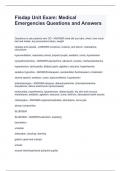Fisdap Unit Exam: Medical
Emergencies Questions and Answers
Questions to ask patients who OD - ANSWER-what did you take, when, how much,
last oral intake, any precautions taken, weight
Opiates and opioids - ANSWER-morphine, codeine, and heroin, methadone,
oxycodone
hypoventilation, respiratory arrest, pinpoint pupils, sedation, coma, hypotension
sympathomimetics - ANSWER-epinephrine, albuterol, cocaine, methamphetamine
hypertension, tachycardia, dilated pupils, agitation, seizures, hyperthermia
sedative hypnotics - ANSWER-diazepam, secobarbital, flunitrazepam, midazolam
slurred speech, sedation, coma, hypoventilation, hypotension
anticholinergics - ANSWER-atropine, diphenhydramine, chloropheniramine,
doxylamine, datura stramonium (jimsonweed)
tachycardia, hyperthermia, hypertension, dilated pupils, dry skin and mucous
membranes, sedation, agitation, seizures, coma, delirium, decreased bowel sounds
cholinergics - ANSWER-organophosphates, pilocarpine, nerve gas
airway compromise
SLUDGEM
SLUDGEM - ANSWER-salivation, sweating
lacrimation
urination
defecation, drooling, diarrhea
gastric upset and cramps
emesis
muscle twitching/miosis (pinpoint pupils)
,miosis - ANSWER-excessively constricted pupil, often bilateral after exposure to
nerve agents.
Inhaled poisons - ANSWER-can cause hypoxia (CO), airway obstruction and
pulmonary edema (chlorine gas), burning eyes, sore throat, cough, chest pain,
hoarseness, wheezing, respiratory distress, dizziness, confusion, headache, stridor,
seizures, altered mental status,
treat by removing the patient from exposure and applying oxygen
some inhaled agents cause progressive lung damage and damage may not be
evident for several hours. It may take 2-3 days or more of ICU to restore normal lung
function.
prompt transport, O2 via non rebreathing and possible positive pressure ventilation if
necessary. pulse oximetry readings may be inaccurate with inhaled poisons. suction
if necessary.
Absorbed and surface contact poisons - ANSWER-corrosive substances will damage
the skin, mucous membranes, eyes, cause chemical burns, rashes, or lesions,.
acids/alkalis, petroleum (hydrocarbon) products are destructive to the skin and
external tissue.
distinguish between contact burns and contact absorption
history of exposure, liquid or powder on patient skin, burns, itching, irritation, redness
of skin, odors of substance.
avoid contaminating yourself and others
remove substance from the patient as fast as possible
remove all contaminated cothes
brush off dry powdery substances, flood/flush with water 15-20 minutes. use soap.
irrigate eyes quickly: make sure the fluid runs from the bridge of the nose outward,
initiate on scene and continue during transport; keep the patient eyes open.
ingested poisons - ANSWER-80% of all poisoning is by mouth. usually accidental in
children and purposeful in adults.
GI problems, cardiac problems, neurological problems.
injected poisons - ANSWER-intravenous drug abuse and envenomation by insects,
arachnids, and reptiles.
usually absorbed quickly into the body, can cause intense local tissue destruction.
Often life threatening.
, weakness, dizziness, fever, chills, unresponsiveness, excitability
monitor airway, provide high flow O2, be alert for nausea and vomiting.
remove rings, watches, bracelets from areas around the injection site if swelling
occurs
if poison route or type is unknown, reassess as if unstable
Toxin emergency medical care - ANSWER-perform external decontamination
remove tablets/pill fragments from the patient's mouth, wash/brush dry poison from
the skin.
assess and maintain ABCS
activated charcoal - ANSWER-binds specific toxins and prevents absorption, toxins
leave the body in stool.
not indicated/ineffective with alkali, cyanide, ethanol, iron, lithium, methanol, mineral
acids, or organic solvent poisons.
if patient has decreased LOC or cannot protect their airway (no gag reflex), do not
give activated charcoal.
premixed suspension bottles usually contain up to 50g of activated charcoal.
usual dose for adult or child is 1g per kg of body weight.
Average in adults in 30-100g, average in children is 15-30g for children younger than
age 13.
always obtain approval from medical control.
most effective if used within 1 hour of ingestion.
shake the bottle vigorously to mix the suspension after patient rights and medical
control
looks like mud so cover it up, have patient drink with a straw
mix as needed to keep it suspended.
document any refusal
impacts include constipation, black stools, vomiting (after which dose has to be
repeated), be prepared for vomiting, nausea, and possible airway conditions
use a large plastic garbage bag to hang on the patient as a bib.




